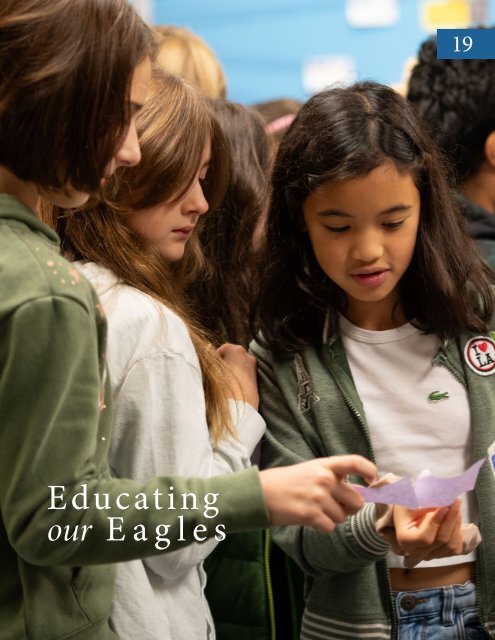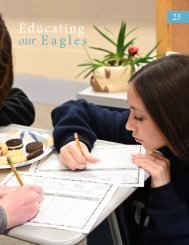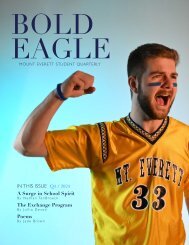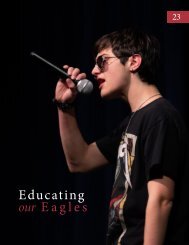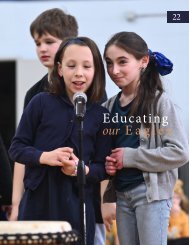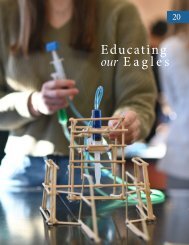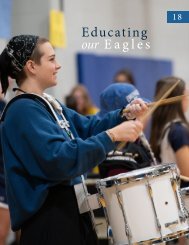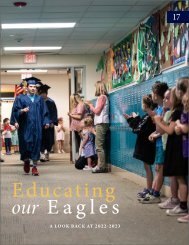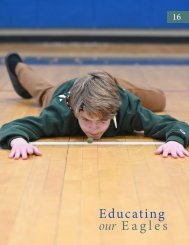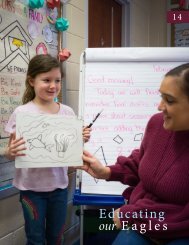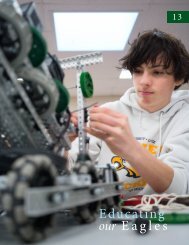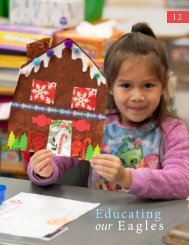Educating Our Eagles - Issue 19
Create successful ePaper yourself
Turn your PDF publications into a flip-book with our unique Google optimized e-Paper software.
<strong>Educating</strong><br />
our <strong>Eagles</strong><br />
<strong>19</strong>
CONTENTS<br />
4<br />
Introduction - Curriculum Director, Julie Dolan<br />
6<br />
Eighth Grade - Foil and Oil – Kari Giordano<br />
8<br />
Tenth Grade - Muslim Studies – Alex Izatt<br />
10<br />
Ninth Grade - Triangle Congruence– Tim Schwartz<br />
12<br />
Kindergarten- I Am My Own Individual – Sarah Gillooly<br />
13<br />
Sixth Grade - Domesticated Animal Research Project – Peter Lynch<br />
14<br />
Fifth Grade - Dia de los Muertos – Susana Mapstone<br />
16<br />
Twelfth Grade - Characters of the Spanish speaking world – Angela Spitia<br />
Seventh-grade students catch their h<br />
air balloon after releasing them in th<br />
annual tradition.<br />
EDUCATING OUR EAGLES<br />
2
otis<br />
EDUCATING OUR EAGLES<br />
3
INTRODUCTION<br />
From SBRSD’s Director of Curriculum<br />
and Instruction, Julie Dolan<br />
The <strong>Eagles</strong> are Thriving this Fall!<br />
Students are hitting their stride this fall with so many opportunities available to<br />
them both academically and with extracurricular activities!<br />
There are multiple Early College offerings this semester that are being taught on our<br />
Sheffield campus by Mt. Everett Faculty. This allows for more college credits to be<br />
earned and makes the transition to college-level course work less intimidating.<br />
The Innovation Pathway Designation in the areas of Advanced Manufacturing<br />
and Information Technology have brought the district new community partners,<br />
which will allow students the chance to not only explore certifications but also to<br />
visit these businesses and even open the door to future internship experiences.<br />
The Robotics and Drone programs continue to be extremely popular as well<br />
as cutting edge, and Mount Everett Regional School is now one of the first<br />
educational institutions in the state to become a recognized identification area<br />
(FRIA) by the Federal Aviation Administration (FAA). This means the school<br />
campus is now officially approved to fly drones on school grounds. This new<br />
certification will help the school district to continue to expand its forwardthinking<br />
course offerings, providing students with opportunities to explore<br />
cutting-edge technologies and innovations.<br />
The partnership with Transcend is also in full swing with approximately 50<br />
stakeholders participating as members of the Core, Design, and Community<br />
Teams. We are currently in the process of engaging our school community in<br />
focus groups, meetings, surveys, etc. to obtain ideas and feedback on our schools<br />
now as well as what we want them to be in the future. We will strive to pilot some<br />
of the ideas coming out of this work beginning in January of 2024!<br />
<strong>Our</strong> students have been excelling in after-school programs as well! <strong>Our</strong> sports<br />
teams saw full participation, the Elementary Musical was a huge hit, Shakespeare<br />
and Company rehearsals are in full swing, the chorus and band concerts will be<br />
coming up very soon, and of course there are many clubs and activities for just<br />
about any area of interest a student may have!<br />
Enjoy this month’s view from our classrooms! We love sharing all the great things<br />
happening each day!<br />
All My Best,<br />
Julie Dolan<br />
Right: SBRSD students perform at Opening Night of<br />
Willy Wonka Kids!<br />
EDUCATING OUR EAGLES<br />
4
5
MIDDLE SCHOOL:<br />
Foil and Oil<br />
In the early 20th century, Japanese artist Kanae Yamamoto published a book explaining<br />
his ideas for teaching children in a way that allowed them to explore, be creative, and<br />
express themselves through art. Known as the “Jiyu-ga” method (from “Jiyuu,” meaning<br />
“freedom”), it was met with enthusiastic support and also strong opposition. Two teachers<br />
who supported Kanae's ideas believed that art education could only progress with the use of<br />
modern art supplies. Up until then, Japanese children were taught to use black ink and follow<br />
strict guidelines. The teachers invented an oil, wax, and pigment stick that allowed students to<br />
experience bold color, the immediacy of drawing, and the expressiveness of painting all at the<br />
same time. It was the first oil pastel. In the spirit of Jiyuu, this “Oil & Foil” technique presents<br />
a new, freely-expressive way for students to experiment with texture, color, and light. It starts<br />
with a collage of foil paper followed by layers of oil pastel. Techniques of debossing and<br />
sgraffito reveal the metallic glow in just the right areas. Expression and depth are created by<br />
contrasting areas of shine and matte, smoothness and texture, plus bright and subdued color.<br />
Whether abstract or representational, art created on foil with oil pastels is as appealing to make<br />
as it is to view.<br />
As a result of instruction, students will be able to:<br />
• use 2-d materials to create a unique collage based on their imaginative drawings.<br />
• practice Sgraffito and Debossing.<br />
• combine colors and textures.<br />
Observations:<br />
This project, adapted from dickblick.com, was a successful way to start the 8th grade<br />
quarter. The students were excited by the variety of materials available to them and the<br />
freedom of the project.<br />
MA Standards:<br />
Develop and refine artistic techniques and work for presentation.<br />
Refine and complete artistic work.<br />
Apply criteria to evaluate artistic work.<br />
EDUCATING OUR EAGLES<br />
6
EDUCATING OUR EAGLES<br />
7
HIGH SCHOOL:<br />
Muslim Culture<br />
Tenth grade students have been learning about unique elements of Muslim culture. In<br />
this lesson we focused on art, specifically the art of calligraphy. After looking at a few<br />
examples of calligraphy. Students tried to write their name in Arabic. Once they accomplished<br />
this, students took it a step farther and tried to add detail and make it look like calligraphy.<br />
Students were allowed to use their name or any phrase/quote that they liked in the final<br />
assignment.<br />
As a result of instruction, students will be able to:<br />
• recognize examples of Muslim culture, specifically art and architecture.<br />
• write their name in Arabic (the language that is only used when worshipping in Islam).<br />
• practice writing their names in a calligraphy art style.<br />
• explain calligraphy and why it is important to Muslim culture.<br />
Observations:<br />
Most students really enjoyed writing their names in Arabic. Students enjoyed looking at<br />
images of muslim artwork and architecture. Some students really threw themselves into the<br />
calligraphy activity, but some students complained about having to do artwork in history<br />
class.<br />
MA Standards:<br />
Use information from primary and secondary sources to research contributions of one of the<br />
ancient Mesopotamian, Egyptian, Phoenician, Israelite, Islamic, and Eurasian societies to the<br />
modern world, the Abbasid Caliphate in western Asia and North Africa (750–1258 CE) and the<br />
flourishing of Islamic arts, science, and learning<br />
EDUCATING OUR EAGLES<br />
8
EDUCATING OUR EAGLES<br />
9
HIGH SCHOOL:<br />
Triangle Congruence<br />
This ninth grade lesson involves the determination of triangle congruence. Students<br />
are required to evaluate the congruence based not only on measurements but also<br />
on rigid mapping of one figure onto the other. This mapping is a series of rigid<br />
transformations. This rigid transformation helps students grasp the concepts of congruence.<br />
Congruence is defined by this concept of rigid mapping.<br />
As a result of instruction students will be able to:<br />
• determine whether or not two figures are congruent.<br />
Observations:<br />
Students liked the process of moving figures by the rules of transformations. They could<br />
literally watch the figures mapping themselves onto one another.<br />
MA Standards:<br />
Geometry, Congruence, B.8. Explain how the criteria for triangle congruence (ASA, SAS,<br />
& SSS) follow the definition of congruence in terms of rigid motions.<br />
EDUCATING OUR EAGLES<br />
10
EDUCATING OUR EAGLES<br />
11
ELEMENTARY SCHOOL:<br />
I am my own individual<br />
To go along with our Literacy lesson, we read the book I Like Myself. We learned that no<br />
matter what we wish for or how we may change on the outside, that we are still the same<br />
person on the inside!<br />
As a class we went on a leaf hunt finding leaves that were fresh and not crumbly. The next day we<br />
started our lesson by looking at our reflection in the mirror to notice the color of our eyes, skin, etc.<br />
Then we took to our desks drawing and coloring ourselves. One at a time the children were called to<br />
put leaves on their self-portrait. The excitement was at an all-time high!<br />
As a result of instruction, students will be able to:<br />
• go on a leaf hunt to find leaves they want to turn into their hair.<br />
• create a self portrait of themselves.<br />
• see the different attributes we have as a person.<br />
• learn that everyone looks different on the outside.<br />
Observations:<br />
I observed children looking at one another, and talking to their partner about their eye colors,<br />
how their skin is darker or lighter than each others. While the class was busy working, I observed<br />
friends talking about the colors they are using for their clothes, and how they are creating their<br />
self portrait to look exactly how they are looking today, clothes and all. When it came time to add<br />
leaves for the hair, one child at a time was called to place the leaves and I glued them down with<br />
a hot glue gun. Once a picture was complete, I held it up and said “Here is (name).” The class<br />
responded with making exciting noises. This happen for all 16 children's self-portraits.<br />
MA Standards:<br />
Ask and answer questions in order to see help, get information, or clarify something that is not<br />
understood.<br />
Add drawing or other displays to describe as desired to provide additional detail.<br />
EDUCATING OUR EAGLES<br />
12
EDUCATING OUR EAGLES<br />
13
MIDDLE SCHOOL:<br />
Domesticated Animal Research Project<br />
Mount Everett sixth-graders are currently learning about agriculture, the domestication of<br />
animals, and how that led to the beginnings of permanent settlements. The class split up into<br />
partners or trios and picked a domesticated animal they would be interested in researching<br />
the history of. They were responsible for researching from online resources and gathering relevant<br />
information on their animal. This included information such as when and where the animal was<br />
domesticated, why it was domesticated, and if modern humans still use this animal for the same purposes<br />
today. They then converted their gathered research into a Google Slides presentation, which they then<br />
shared with the class. We will be continuing this learning when we conduct some science experiments and<br />
observe apples over time while learning about the process of decomposition.<br />
As a result of instruction, students will be able to:<br />
• understand how agriculture and the domestication of animals impacted Neolithic societies.<br />
Observations:<br />
My classes were excited to be able to pick animals they were passionate about. Some picked pets they had at<br />
home or animals they wanted to learn more about. These groups spent a lot of time and effort polishing their<br />
slides to make sure they were ready to be presented, and most were enthusiastic about getting in front of the<br />
class and share their work.<br />
MA Standards:<br />
Explain that the term Neolithic Era refers to the period beginning about 10,000 years ago to c. 4500 or c.<br />
2000 BCE in different parts of the world, in which the technologies of agriculture (growing crops and the<br />
domestication of animals) and metallurgy (mining and working of metals) were invented and refined, and in<br />
which complex societies begin to appear.<br />
EDUCATING OUR EAGLES<br />
14
EDUCATING OUR EAGLES<br />
15
ELEMENTARY SCHOOL:<br />
Dia de los Muertos - Day of the Dead<br />
It is a day to honor and commemorate the lives of the dearly departed and to welcome<br />
the return of their spirits. The tradition of the Day of the Dead is rooted in Indigenous<br />
and Spanish ritual customs. Today, this celebration has been increasingly popular among<br />
Latinos in the United States. Though many of the traditional elements have remained, the<br />
way and where the Day of the Dead is celebrated has changed. However, the unity of life and<br />
death continues to be the dominant theme of the art, tradition, and rituals of the annual<br />
celebration of the Day of the Dead on Nov. 2, both in Mexico and the United States.<br />
As a result of instruction students will be able to:<br />
• understand how the Day of the Dead (Día de los Muertos)<br />
is celebrated in Mexico and other parts of the world.<br />
• discuss their family's traditions and ways that they honor<br />
and remember people who have passed away.<br />
• compare and contrast our Halloween festivities with other<br />
culture's holidays, specifically el Dia de los Muertos.<br />
Observations:<br />
The 5th graders learned about making an ofrenda in our<br />
classroom and enjoyed making and decorating sugar skulls.<br />
MA Standards:<br />
Communication 1.1 Discuss culturally relevant topics and show respect to other people's beliefs.<br />
Culture 2-1 Students demonstrate an understanding of the relationship between the practices and<br />
perspectives of the cultures studied.<br />
2.2 Students demonstrate an understanding of the relationship between the products and perspectives<br />
of the cultures studied.<br />
Connections<br />
3.2 Students acquire information and recognize the distinctive viewpoints that are only available<br />
through the foreign language and its cultures.<br />
Comparisons<br />
4.2 Students demonstrate understanding of the concept of culture through comparisons of the<br />
cultures studied and their own.<br />
EDUCATING OUR EAGLES<br />
16
HIGH SCHOOL:<br />
Characters of the Spanish-speaking world<br />
Spanish Language students will research about different people from Latin America and<br />
Spain who have left a mark in history and are an inspiration to others. These people have<br />
shown that with hard work and resiliency they can achieve their goals. They have inspired<br />
other people to better themselves and their communities. Some of them are still in their<br />
countries, others are immigrants, and others are of Hispanic heritage. Throughout this lesson,<br />
each student will research a different person in the target language. They will write a report in<br />
Spanish and give an oral presentation in Spanish to the other students in class about what they<br />
have learned.<br />
As a result of instruction students will be able to:<br />
• learn more about very important Latin American and Spanish people who have made<br />
history and are making a great impact in the world.<br />
• learn about the diversity of professions these characters have and try to identify with<br />
some of them.<br />
• learn about their great contributions to our communities and to humanity at large.<br />
• practice reading, writing, listening and speaking using only the target language.<br />
Observations:<br />
The students had fun learning about these people while they continued perfecting<br />
pronunciation and fluency.<br />
MA Standards:<br />
1. Interpretive Communication - In narrative, descriptive, and persuasive texts and<br />
conversations on a variety of concrete topics of personal, general, or public interest, relying<br />
upon understanding of short paragraphs containing multiple time frames, consisting of<br />
straightforward or descriptive language.<br />
a. Analyze traits of multiple cultures and communities. (IH.1.a)<br />
b. Analyze the main message or story line and some supporting details. (IH.1.b)<br />
3. Presentational Communication - In presentations on a variety of concrete topics of<br />
personal, general, or public interest, in a wide variety of settings, creating mostly short<br />
paragraphs, sometimes relying upon circumlocution, in such a way that speakers/signers of<br />
the language usually understand.
Use This code to hear<br />
Nathan's Recording!
EDUCATING OUR EAGLES<br />
20


